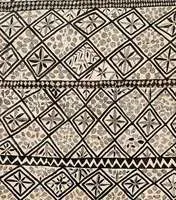John Pule Looks at Pacific Art Form
Written by

The beautiful Hiapo - a remarkable art form revealed
The first, and only, book about a stunning art form is about to be published. Hiapo - the barkcloth or tapa of Niue - is a neglected art form produced in the mid-to-late nineteenth century. John Pule, a Niuean artist and writer, and Nicholas Thomas, an Australian writer, anthropologist and historian, have spent ten years combing through these museums searching for surviving hiapo.
Image: Hiapo - barkcloth of Niue (detail of mat)The beautiful Hiapo - a remarkable art form revealed
The first, and only, book about a stunning art form is about to be published. Hiapo - the barkcloth or tapa of Niue - is a neglected art form produced in the mid-to-late nineteenth century. John Pule, a Niuean artist and writer, and Nicholas Thomas, an Australian writer, anthropologist and historian, have spent ten years combing through these museums searching for surviving hiapo.
Image: Hiapo - barkcloth of Niue (detail of mat)Surviving pieces are now dispersed, largely in museum collections in North America, the Pacific and throughout Europe. Pule and Thomas also visited Niue and spoke to people on the island to find out more about the art form. Hiapo: Past and Present in Niuean Barkcloth publishes almost all the painted hiapo they were able to locate on their journeys.
Hiapo offer a window on a time when missionary impact was deepening and Niuean life was changing forever. These powerful works of art are often more than two metres long and usually painted in black. The paintings range from abstract patterns to detailed renderings of plants, peoples and objects. They contain a revealing mixture of Niuean and European imagery: furniture, ships and marine tools sit alongside symbols of marine life, plants and leaves. Some include words; another a woman dressed in a crinoline.
Missionaries and visitors to Niue collected these hiapo, resulting in their wholesale displacement from the island. Only one complete hiapo remains on Niue, and that was repatriated by the New Zealand government in the 1970s. It sits behind the Speaker's chair in Parliament.
Hiapo is a personal response to Niue, hiapo and the museums in which they are stored. John Pule's response to hiapo is based on his personal understanding of the art form, and what hiapo means to him as an artist and poet. A series of his etchings are included in the book. Nicholas Thomas's contributions are shaped by his research on art and culture in the Pacific, and by a personal commitment to recover the objects and stories of the colonial Pacific. Hiapo is published by University of Otago Press.